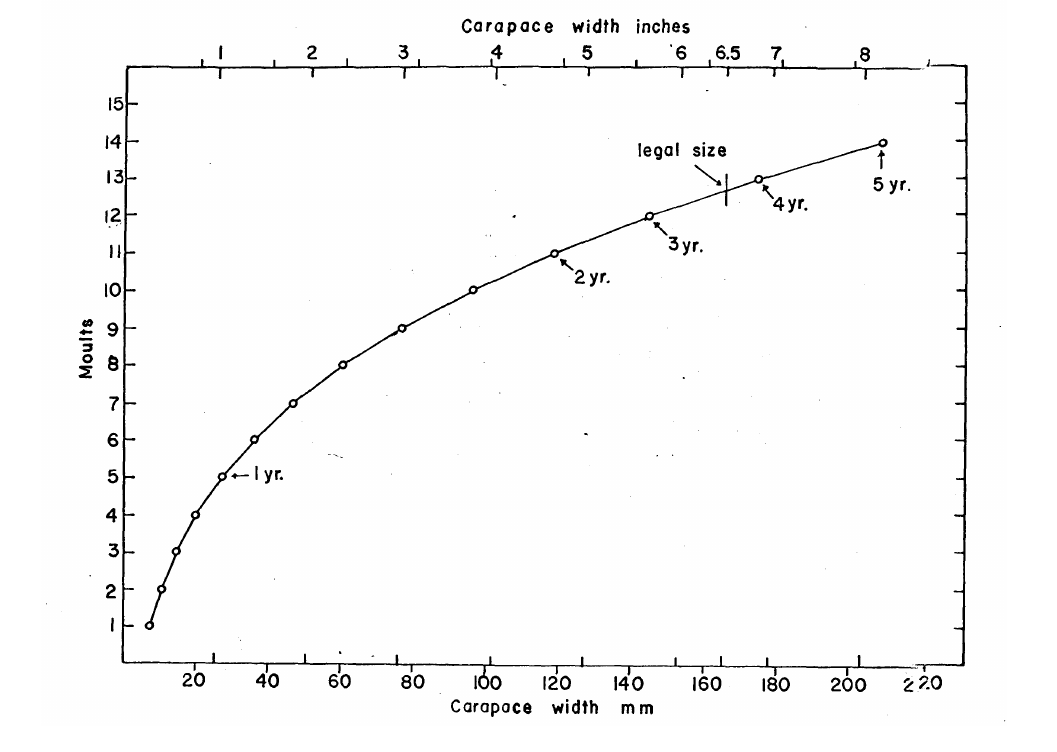Evaluating rules for opening and closing the crab fishery
- Investigation of weekly exploitation rates
- Evaluation of possible seasonal changes in crab vulnerability
- Prospective simulation
Three Chapters
- Introduce model and fit to data assuming only size dependent vulnerability.
- Extend model to the time dependent vulnerability regimes and use size composition data from soft shell survey.
- Prospective analysis
Chapter 1 Model
- Fit model to weekly catch and effort data
- Develop main components of model
- Simulation test model
Single Agent Loop
Advance
Go Fish
Flow chart of Population Model

Mortality
$$A=A(1-M_{sc})$$Negative Log-Likelihood
$$nll(x) = \sum{-log(\frac{1}{{\sigma \sqrt {2\pi } }}e^{{{ - \frac{\left( {C - \hat{C} } \right)^2}{2 \sigma^2} }}}}) $$ With the right indices to make catches by week make sense.Chapter 1 Results
- Are there seasonal patterns in weekly exploitation rates?
- Is there evidence, in the depletion series, for the commonly held belief that more than \( 90 \% \) of the legal crabs are harvested?
Chapter 2 Vulnerability Regime
- Adding Size Composition
- Able to estimate a scalar natural mortality
- Likelihood profiles of various vulnerability regimes
Time-Dependent Vulnerability Hypothesis
- Crabs feed more intensely just prior to and after hardening up after a molt and make themselves more vulnerable to capture during these shell conditions
- There are simply seasonal changes in vulnerability, these changes do not depend on shell condition or number of traps in the water.
- Crabs aggregate due to the presence of baited traps, increasing catch rate
Shell condition vulnerability
The Catch equation becomes $$C=qv_{a,t}E_tA_t$$ \begin{eqnarray} v_{a,t}&=&1 \mbox{ if } SC_a=1 \\ v_{a,t}&=&\alpha \mbox{ if } SC_a\ne 1 \end{eqnarray}Seasonal Vulnerability
The Catch equation becomes $$C=qv_{a,t}E_tA_t$$Crabs are fully vulnerable from May until September.
These dates are arbitrary. \begin{eqnarray} v_{a,t}&=&1 \mbox{ if } 18\leq t \leq36 \\ v_{a,t}&=&\alpha \mbox{ otherwise } \end{eqnarray} Shortened period of full vulnerability \begin{eqnarray} v_{a,t}&=&1 \mbox{ if } 22\leq t \leq26 \\ v_{a,t}&=&\alpha \mbox{ otherwise } \end{eqnarray}Effort Vulnerability
\begin{eqnarray} \label{eq:effortvul} VW_{t+1}&=&.4\frac{E_t}{40000}+(1-.4)VW_t\\ v_{a,t}&=&1 \mbox{ if } \alpha\cdot VW_t >=1 \mbox{ or } SC_a=1 \mbox{ and } weeks<=2\\ v_{a,t}&=&\alpha VW_t \end{eqnarray}Time-Independent Vulnerability
- Vulnerability varies randomly between crabs
- Vulnerability is constant between all crabs.
Variable vulnerability
$$V_{a}\sim U(0,1)$$Negative Log-Likelihood
$$nll(x) = \sum{-log(\frac{1}{{\sigma \sqrt {2\pi } }}e^{{{ - \frac{\left( {C - \hat{C} } \right)^2}{2 \sigma^2} }}}})-\sum{S \cdot log(\hat{S}) W_{sample} }$$ With the right indices to make proportions at size for each year and catches by week make sense.Chapter 2 Results
- How to figure out quantitative vulnerability scenarios?
- What drives effort?
- What Management Scenarios and indicators am I missing?
$$CVRMSE$$
|sim|est|q|TC|OC|A|U| |:---|---|---|---|---|---|---|---|---|---|---|---|---| |const|const | -0.00 | -0.05 | 0.02 | 0.05 | 0.04| |const|var | 1.63 | 0.40 | 1.05 | 0.05 | 2.59 | |const|shell | -0.35 | 1.18 | 0.30 | 0.04 | 0.59| |var| const | -0.44 | -0.27 | 0.28 | 0.03 | 0.61| |var|var | 0.00 | -0.07 | 0.02 | 0.03 | 0.03| |var|shell | -0.36 | 0.67 | 0.33 | 0.03 | 0.46 | |shell|const | 0.46 | 0.08 | 0.82 | 0.04 | 0.63| |shell|var |0.62 | 0.15 | 0.59 | 0.04 | 1.42 | |shell|shell |0.00 |-0.06 | 0.08 | 0.04 | 0.09|
Chapter 3
- Three different rules for setting opening and closing dates
- Four different vulnerability hypothesis: constant, variable, shell condition and effort.
- Two different models of effort: a linear function of cpue in the previous week and a linear function of cpue in the previous week and average windspeed in present week.

